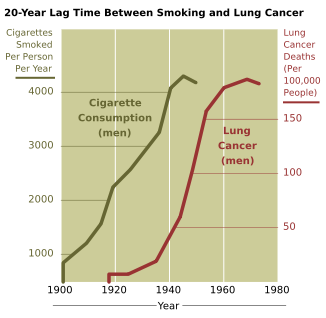Lung cancer epidemiology and demographics
|
Lung cancer Microchapters |
|
Diagnosis |
|---|
|
Treatment |
|
Case Studies |
|
Lung cancer epidemiology and demographics On the Web |
|
American Roentgen Ray Society Images of Lung cancer epidemiology and demographics |
|
Risk calculators and risk factors for Lung cancer epidemiology and demographics |
Editor-In-Chief: C. Michael Gibson, M.S., M.D. [1]; Associate Editor(s)-In-Chief: Kim-Son H. Nguyen, M.D., M.P.A., Beth Israel Deaconess Medical Center, Harvard Medical School, Boston MA, Cafer Zorkun, M.D., Ph.D. [2]
Overview
Worldwide, lung cancer is the most common cancer in terms of both incidence and mortality with 1.35 million new cases per year and 1.18 million deaths, with the highest rates in Europe and North America. The population segment most likely to develop lung cancer is over-fifties who have a history of smoking. Lung cancer is the second most commonly occurring form of cancer in most western countries, and it is the leading cancer-related cause of death. Although the rate of men dying from lung cancer is declining in western countries, it is actually increasing for women due to the increased takeup of smoking by this group. Among lifetime non-smokers, men have higher age-standardized lung cancer death rates than women.
Prevalence by Cause
Smoking
Smoking, particularly of cigarettes, is by far the main contributor to lung cancer. In the United States, smoking is estimated to account for 87% of lung cancer cases (90% in men and 85% in women).[1]
Among male smokers, the lifetime risk of developing lung cancer is 17.2%. Among female smokers, the risk is 11.6%. This risk is significantly lower in non-smokers: 1.3% in men and 1.4% in women.[2]
Prevalence by Age

Lung cancer is more common in older adults. Smoking can cause eventual death over a significant period of time, which explains why it is rare in people under the age of 45. There is a clear correlation between an increase in the volume of smoking and the total number of lung cancer deaths. Studies have shown that there is approximately a 20 year lag period between smoking and death due to lung cancer (in men).
Prevalence by Geographic distribution
Eastern Europe has the highest lung cancer mortality among men, while northern Europe and the U.S. have the highest mortality among women. Lung cancer incidence is currently less common in developing countries.[3] With increased smoking in developing countries, the incidence is expected to increase in the next few years, notably in China[4] and India.[5]
References
- ↑ Samet, JM (May 1988). "Cigarette smoking and lung cancer in New Mexico". American Review of Respiratory Disease. 137 (5): 1110–1113. PMID 3264122. Unknown parameter
|coauthors=ignored (help) - ↑ Villeneuve, PJ (Nov 1994). "Lifetime probability of developing lung cancer, by smoking status, Canada". Canadian Journal of Public Health. 85 (6): 385–388. PMID 7895211. Unknown parameter
|coauthors=ignored (help) - ↑ "Gender in lung cancer and smoking research" (PDF). World Health Organization. 2004. Retrieved 2007-05-26.
- ↑ Liu, BQ (Nov 1998). "Emerging tobacco hazards in China: 1. Retrospective proportional mortality study of one million deaths". British Medical Journal. 317 (7170): 1411–1422. Retrieved 2007-09-27. Unknown parameter
|pmidbr=ignored (help); Unknown parameter|coauthors=ignored (help) - ↑ Behera, D (2004). "Lung cancer in India". Indian Journal of Chest Diseases and Allied Sciences. 46 (4): 269–281. PMID 15515828. Unknown parameter
|coauthors=ignored (help)